Financial Analysis and Strategies for City Brasserie Ltd: Finance
VerifiedAdded on 2020/01/15
|17
|5303
|159
Report
AI Summary
This report provides a comprehensive financial analysis of City Brasserie Ltd, focusing on the financial aspects of opening a new restaurant. It explores various sources of funding like debt, equity, and retained earnings, recommending equity financing as the most suitable option. The report delves into income generation strategies, including cookery classes, merchandising, and event catering. It evaluates cost elements such as materials, consumables, labor, and overheads, and discusses methods for increasing gross profit. Business methods like stocktaking and cash security are also assessed. The report covers the structure and source of a trial balance, evaluates business accounts, and explains the purpose of financial budgets and variance analysis. Financial ratios are computed, and recommendations are made for improving financial management. The report also categorizes costs, calculates contribution margin, and suggests strategies for earning desired profits. The report concludes with a summary of findings and recommendations to enhance the financial performance of City Brasserie Ltd.
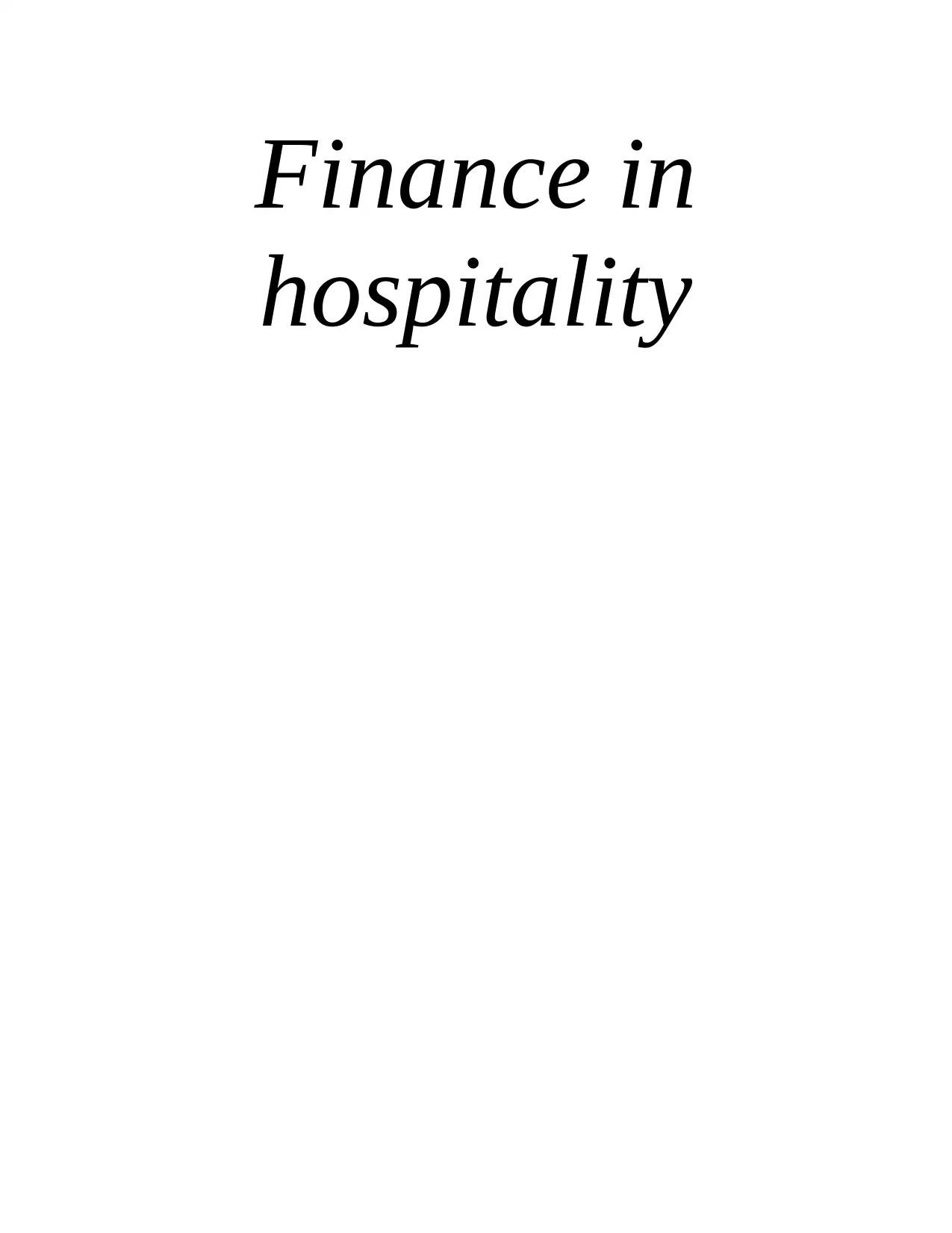
Finance in
hospitality
hospitality
Paraphrase This Document
Need a fresh take? Get an instant paraphrase of this document with our AI Paraphraser
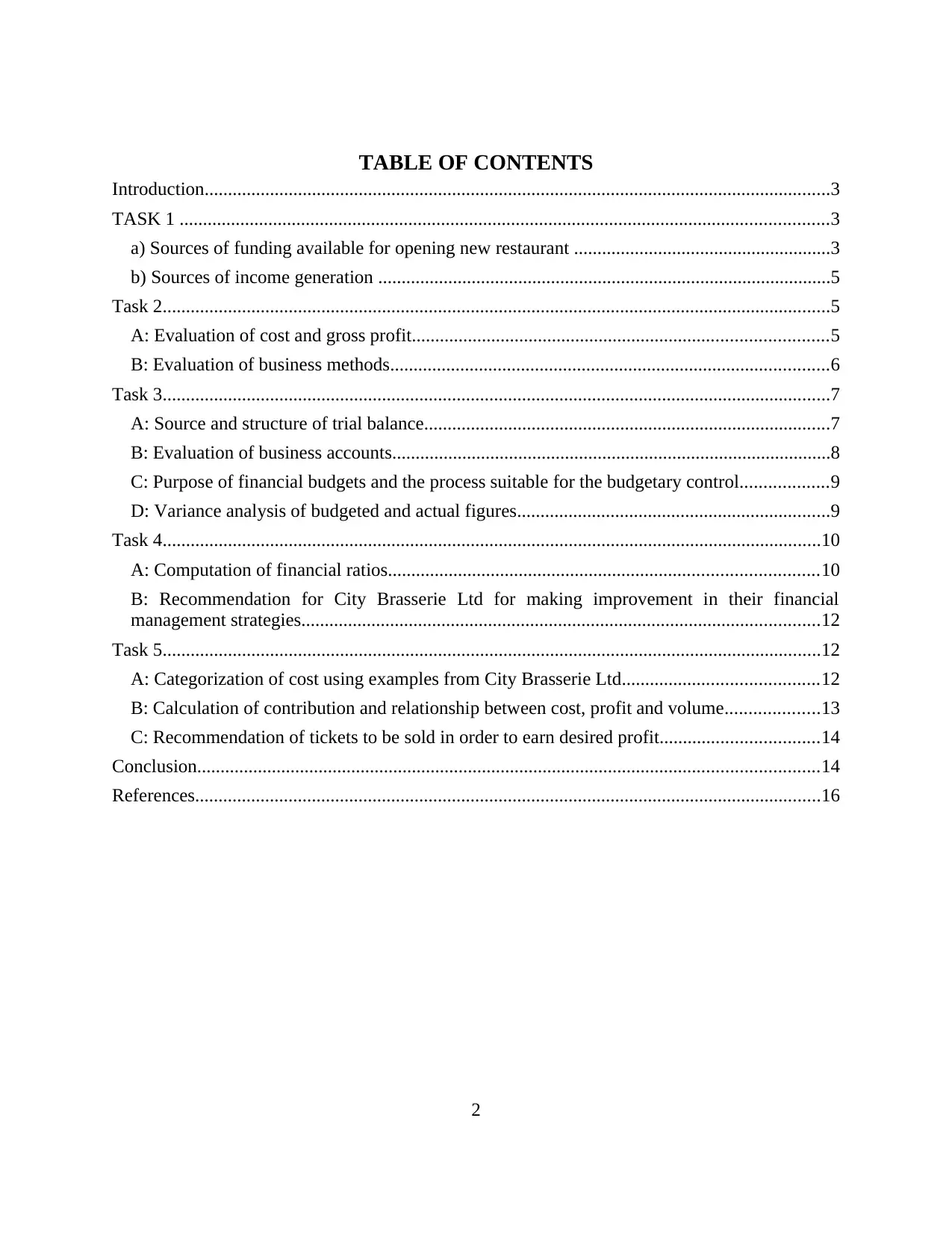
TABLE OF CONTENTS
Introduction......................................................................................................................................3
TASK 1 ...........................................................................................................................................3
a) Sources of funding available for opening new restaurant .......................................................3
b) Sources of income generation .................................................................................................5
Task 2...............................................................................................................................................5
A: Evaluation of cost and gross profit.........................................................................................5
B: Evaluation of business methods..............................................................................................6
Task 3...............................................................................................................................................7
A: Source and structure of trial balance.......................................................................................7
B: Evaluation of business accounts..............................................................................................8
C: Purpose of financial budgets and the process suitable for the budgetary control...................9
D: Variance analysis of budgeted and actual figures...................................................................9
Task 4.............................................................................................................................................10
A: Computation of financial ratios............................................................................................10
B: Recommendation for City Brasserie Ltd for making improvement in their financial
management strategies...............................................................................................................12
Task 5.............................................................................................................................................12
A: Categorization of cost using examples from City Brasserie Ltd..........................................12
B: Calculation of contribution and relationship between cost, profit and volume....................13
C: Recommendation of tickets to be sold in order to earn desired profit..................................14
Conclusion.....................................................................................................................................14
References......................................................................................................................................16
2
Introduction......................................................................................................................................3
TASK 1 ...........................................................................................................................................3
a) Sources of funding available for opening new restaurant .......................................................3
b) Sources of income generation .................................................................................................5
Task 2...............................................................................................................................................5
A: Evaluation of cost and gross profit.........................................................................................5
B: Evaluation of business methods..............................................................................................6
Task 3...............................................................................................................................................7
A: Source and structure of trial balance.......................................................................................7
B: Evaluation of business accounts..............................................................................................8
C: Purpose of financial budgets and the process suitable for the budgetary control...................9
D: Variance analysis of budgeted and actual figures...................................................................9
Task 4.............................................................................................................................................10
A: Computation of financial ratios............................................................................................10
B: Recommendation for City Brasserie Ltd for making improvement in their financial
management strategies...............................................................................................................12
Task 5.............................................................................................................................................12
A: Categorization of cost using examples from City Brasserie Ltd..........................................12
B: Calculation of contribution and relationship between cost, profit and volume....................13
C: Recommendation of tickets to be sold in order to earn desired profit..................................14
Conclusion.....................................................................................................................................14
References......................................................................................................................................16
2
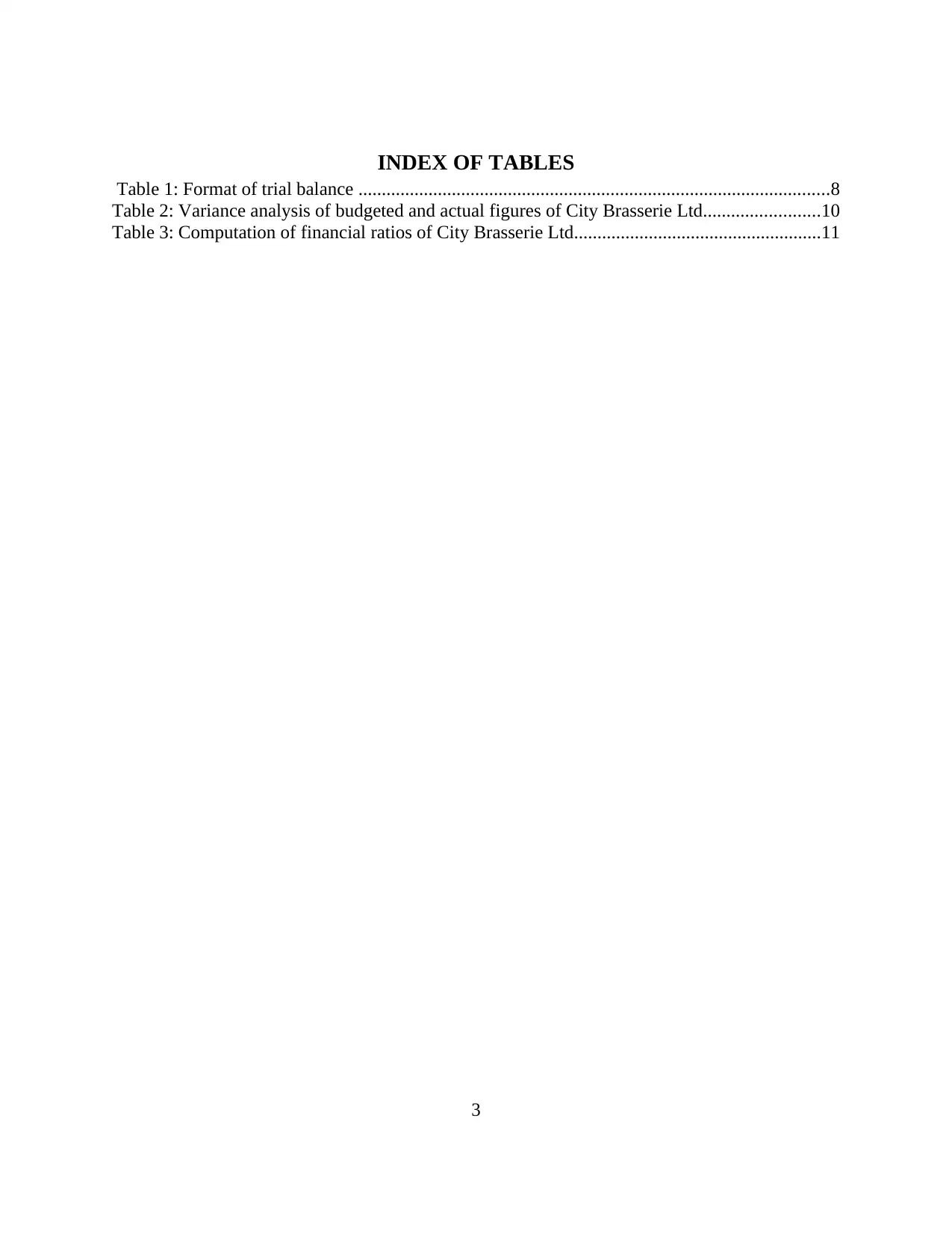
INDEX OF TABLES
Table 1: Format of trial balance .....................................................................................................8
Table 2: Variance analysis of budgeted and actual figures of City Brasserie Ltd.........................10
Table 3: Computation of financial ratios of City Brasserie Ltd.....................................................11
3
Table 1: Format of trial balance .....................................................................................................8
Table 2: Variance analysis of budgeted and actual figures of City Brasserie Ltd.........................10
Table 3: Computation of financial ratios of City Brasserie Ltd.....................................................11
3
⊘ This is a preview!⊘
Do you want full access?
Subscribe today to unlock all pages.

Trusted by 1+ million students worldwide
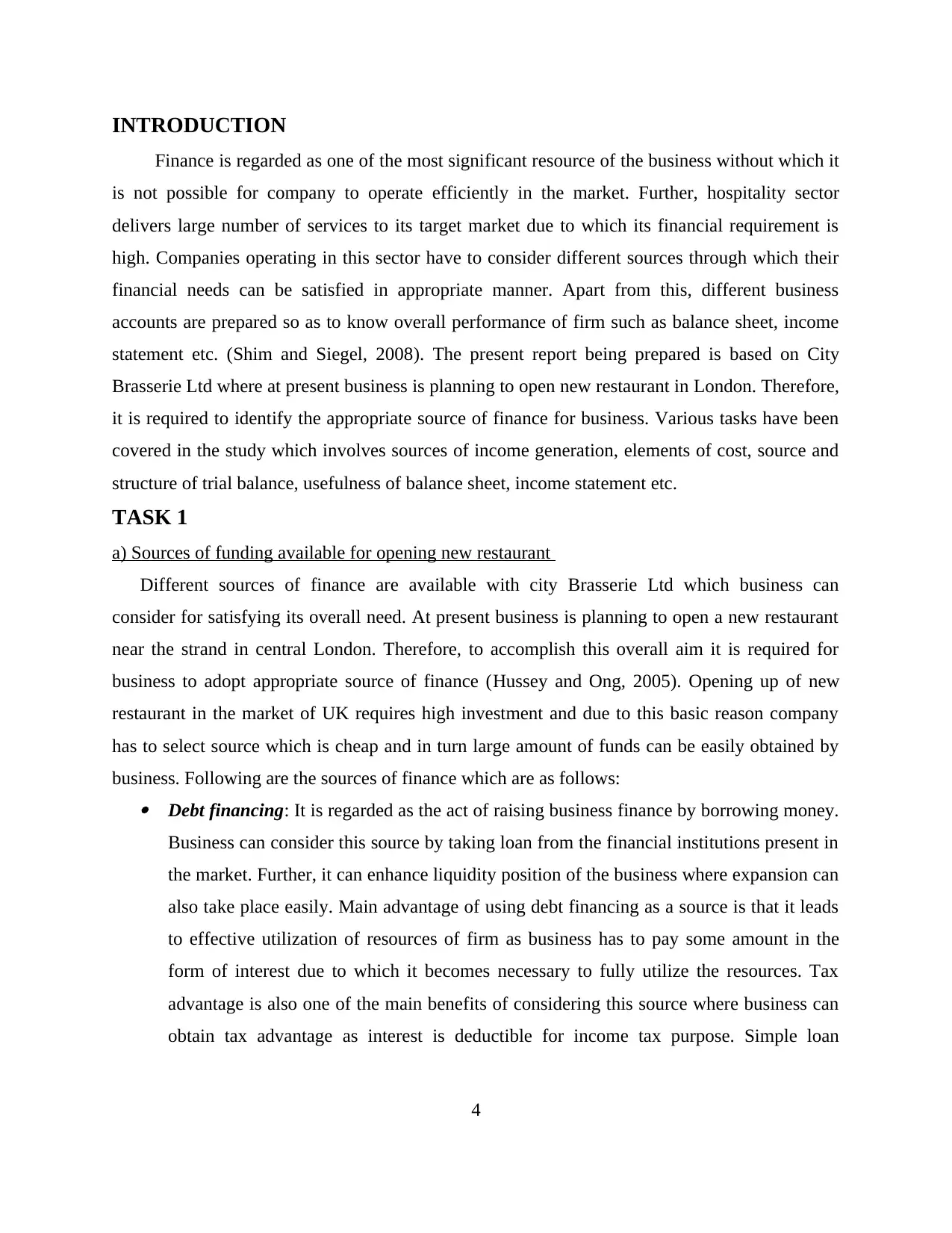
INTRODUCTION
Finance is regarded as one of the most significant resource of the business without which it
is not possible for company to operate efficiently in the market. Further, hospitality sector
delivers large number of services to its target market due to which its financial requirement is
high. Companies operating in this sector have to consider different sources through which their
financial needs can be satisfied in appropriate manner. Apart from this, different business
accounts are prepared so as to know overall performance of firm such as balance sheet, income
statement etc. (Shim and Siegel, 2008). The present report being prepared is based on City
Brasserie Ltd where at present business is planning to open new restaurant in London. Therefore,
it is required to identify the appropriate source of finance for business. Various tasks have been
covered in the study which involves sources of income generation, elements of cost, source and
structure of trial balance, usefulness of balance sheet, income statement etc.
TASK 1
a) Sources of funding available for opening new restaurant
Different sources of finance are available with city Brasserie Ltd which business can
consider for satisfying its overall need. At present business is planning to open a new restaurant
near the strand in central London. Therefore, to accomplish this overall aim it is required for
business to adopt appropriate source of finance (Hussey and Ong, 2005). Opening up of new
restaurant in the market of UK requires high investment and due to this basic reason company
has to select source which is cheap and in turn large amount of funds can be easily obtained by
business. Following are the sources of finance which are as follows: Debt financing: It is regarded as the act of raising business finance by borrowing money.
Business can consider this source by taking loan from the financial institutions present in
the market. Further, it can enhance liquidity position of the business where expansion can
also take place easily. Main advantage of using debt financing as a source is that it leads
to effective utilization of resources of firm as business has to pay some amount in the
form of interest due to which it becomes necessary to fully utilize the resources. Tax
advantage is also one of the main benefits of considering this source where business can
obtain tax advantage as interest is deductible for income tax purpose. Simple loan
4
Finance is regarded as one of the most significant resource of the business without which it
is not possible for company to operate efficiently in the market. Further, hospitality sector
delivers large number of services to its target market due to which its financial requirement is
high. Companies operating in this sector have to consider different sources through which their
financial needs can be satisfied in appropriate manner. Apart from this, different business
accounts are prepared so as to know overall performance of firm such as balance sheet, income
statement etc. (Shim and Siegel, 2008). The present report being prepared is based on City
Brasserie Ltd where at present business is planning to open new restaurant in London. Therefore,
it is required to identify the appropriate source of finance for business. Various tasks have been
covered in the study which involves sources of income generation, elements of cost, source and
structure of trial balance, usefulness of balance sheet, income statement etc.
TASK 1
a) Sources of funding available for opening new restaurant
Different sources of finance are available with city Brasserie Ltd which business can
consider for satisfying its overall need. At present business is planning to open a new restaurant
near the strand in central London. Therefore, to accomplish this overall aim it is required for
business to adopt appropriate source of finance (Hussey and Ong, 2005). Opening up of new
restaurant in the market of UK requires high investment and due to this basic reason company
has to select source which is cheap and in turn large amount of funds can be easily obtained by
business. Following are the sources of finance which are as follows: Debt financing: It is regarded as the act of raising business finance by borrowing money.
Business can consider this source by taking loan from the financial institutions present in
the market. Further, it can enhance liquidity position of the business where expansion can
also take place easily. Main advantage of using debt financing as a source is that it leads
to effective utilization of resources of firm as business has to pay some amount in the
form of interest due to which it becomes necessary to fully utilize the resources. Tax
advantage is also one of the main benefits of considering this source where business can
obtain tax advantage as interest is deductible for income tax purpose. Simple loan
4
Paraphrase This Document
Need a fresh take? Get an instant paraphrase of this document with our AI Paraphraser

repayment is also one of the advantages of this source where lenders are only entitled to
loan repayment and interest on loan (Keller, 2013). Further, future impact forecasting is
also one of the main advantage of this source where principal repayment along with
interest are based on fixed percentage and it is possible to forecast. On the other hand this
source has some disadvantage which are regular payments of installment is required and
this leads to rise in expenditure level of the company. Further, many times it is possible
that financial institutions may impose penalty for late payment and this may have adverse
impact on city Brasserie Ltd. Apart from this failure to make payment on loan can have
negative impact on credit rating of the organization. Therefore, in this way these are some
of the main disadvantage of this source which company has to consider. Equity: For obtaining large amount of funds it is possible for city Brasserie Ltd to issue
equity shares in the market. Further, through this source funds can be obtained from
investors who may purchase shares of company (Cox and Fardon, 2005). Main advantage
of this source is that business does not have to keep cost of debt financing, right business
angels bring valuable skills, investors are attracted to provide follow up funding etc. On
the other hand some disadvantage of this source is that equity financing is demanding,
costly and time consuming.
Retained earnings: It is also regarded as one of the most effective source of finance
where business can utilize its savings for satisfying its expansion needs. Further, main
advantage of this source is that large amount of funds can be obtained easily and it is not
required to bear any cost (Keller, 2013). On the other hand it reduces overall savings of
firm which is major drawback.
Out of all these three sources most appropriate one for city Brasserie Ltd is equity
financing where organization can easily issue equity shares in the market and amount for
expansion can be obtained easily. Main reason behind not recommending debt financing is that
business has already taken loan from bank of large amount and this source will not be
appropriate for firm as interest cost will rise. Further, retained earnings as a source cannot be
considered by business as large amount is required for investment.
5
loan repayment and interest on loan (Keller, 2013). Further, future impact forecasting is
also one of the main advantage of this source where principal repayment along with
interest are based on fixed percentage and it is possible to forecast. On the other hand this
source has some disadvantage which are regular payments of installment is required and
this leads to rise in expenditure level of the company. Further, many times it is possible
that financial institutions may impose penalty for late payment and this may have adverse
impact on city Brasserie Ltd. Apart from this failure to make payment on loan can have
negative impact on credit rating of the organization. Therefore, in this way these are some
of the main disadvantage of this source which company has to consider. Equity: For obtaining large amount of funds it is possible for city Brasserie Ltd to issue
equity shares in the market. Further, through this source funds can be obtained from
investors who may purchase shares of company (Cox and Fardon, 2005). Main advantage
of this source is that business does not have to keep cost of debt financing, right business
angels bring valuable skills, investors are attracted to provide follow up funding etc. On
the other hand some disadvantage of this source is that equity financing is demanding,
costly and time consuming.
Retained earnings: It is also regarded as one of the most effective source of finance
where business can utilize its savings for satisfying its expansion needs. Further, main
advantage of this source is that large amount of funds can be obtained easily and it is not
required to bear any cost (Keller, 2013). On the other hand it reduces overall savings of
firm which is major drawback.
Out of all these three sources most appropriate one for city Brasserie Ltd is equity
financing where organization can easily issue equity shares in the market and amount for
expansion can be obtained easily. Main reason behind not recommending debt financing is that
business has already taken loan from bank of large amount and this source will not be
appropriate for firm as interest cost will rise. Further, retained earnings as a source cannot be
considered by business as large amount is required for investment.
5

b) Sources of income generation
Different sources of income are present which City Brasserie Ltd which business can
consider for enhancing its overall profitability level. Such sources are: Cookery classes: Chefs working in City Brasserie Ltd can organize cookery classes and
can charged fess from individual for the same. This will be appropriate source of income
for company and people can learn about preparing different dishes etc. This services can
be provided by the ideal labour of the restaurant in the morning time in which there are
fewer customers in restaurant (Portz and Lere, 2010). In this manner, they will be able to
make optimum utilization of available resources. Merchandising with cookbooks and kitchen items: For City Brasserie Ltd it is possible
to introduce cookbooks and kitchen items. Further, same can be offered to local public so
that they can know about the ways through which different dishes can be prepared.
Therefore, this will also be appropriate source of income. City Brasserie Ltd is reputed
French restaurant with good market image. On the basis of their goodwill they can sell
their cooking recipes to the customers (Ojha, Gianiodis and Manuj, 2013). For this
activity, they do not required to incur heavy expenses but they can earn good profits from
this source.
Events catering: Company can take catering order of different events such as party,
marriage etc and income can be earned by charging fees from the same. For this source,
they can introduce different themes for their customers in order to make their experience
more memorable. They can also provide their services to the commercial entities by
getting associated with them.
TASK 2
A: Evaluation of cost and gross profit
Elements of costs including labour, consumables and overheads
Elements of cost can be defined as the expenditure occurred by business entity for the
manufacturing process of the cost centres (Curzon and Wingler, 2013). In the context to the City
Brasserie Ltd, description of cost components is as follows:
6
Different sources of income are present which City Brasserie Ltd which business can
consider for enhancing its overall profitability level. Such sources are: Cookery classes: Chefs working in City Brasserie Ltd can organize cookery classes and
can charged fess from individual for the same. This will be appropriate source of income
for company and people can learn about preparing different dishes etc. This services can
be provided by the ideal labour of the restaurant in the morning time in which there are
fewer customers in restaurant (Portz and Lere, 2010). In this manner, they will be able to
make optimum utilization of available resources. Merchandising with cookbooks and kitchen items: For City Brasserie Ltd it is possible
to introduce cookbooks and kitchen items. Further, same can be offered to local public so
that they can know about the ways through which different dishes can be prepared.
Therefore, this will also be appropriate source of income. City Brasserie Ltd is reputed
French restaurant with good market image. On the basis of their goodwill they can sell
their cooking recipes to the customers (Ojha, Gianiodis and Manuj, 2013). For this
activity, they do not required to incur heavy expenses but they can earn good profits from
this source.
Events catering: Company can take catering order of different events such as party,
marriage etc and income can be earned by charging fees from the same. For this source,
they can introduce different themes for their customers in order to make their experience
more memorable. They can also provide their services to the commercial entities by
getting associated with them.
TASK 2
A: Evaluation of cost and gross profit
Elements of costs including labour, consumables and overheads
Elements of cost can be defined as the expenditure occurred by business entity for the
manufacturing process of the cost centres (Curzon and Wingler, 2013). In the context to the City
Brasserie Ltd, description of cost components is as follows:
6
⊘ This is a preview!⊘
Do you want full access?
Subscribe today to unlock all pages.

Trusted by 1+ million students worldwide
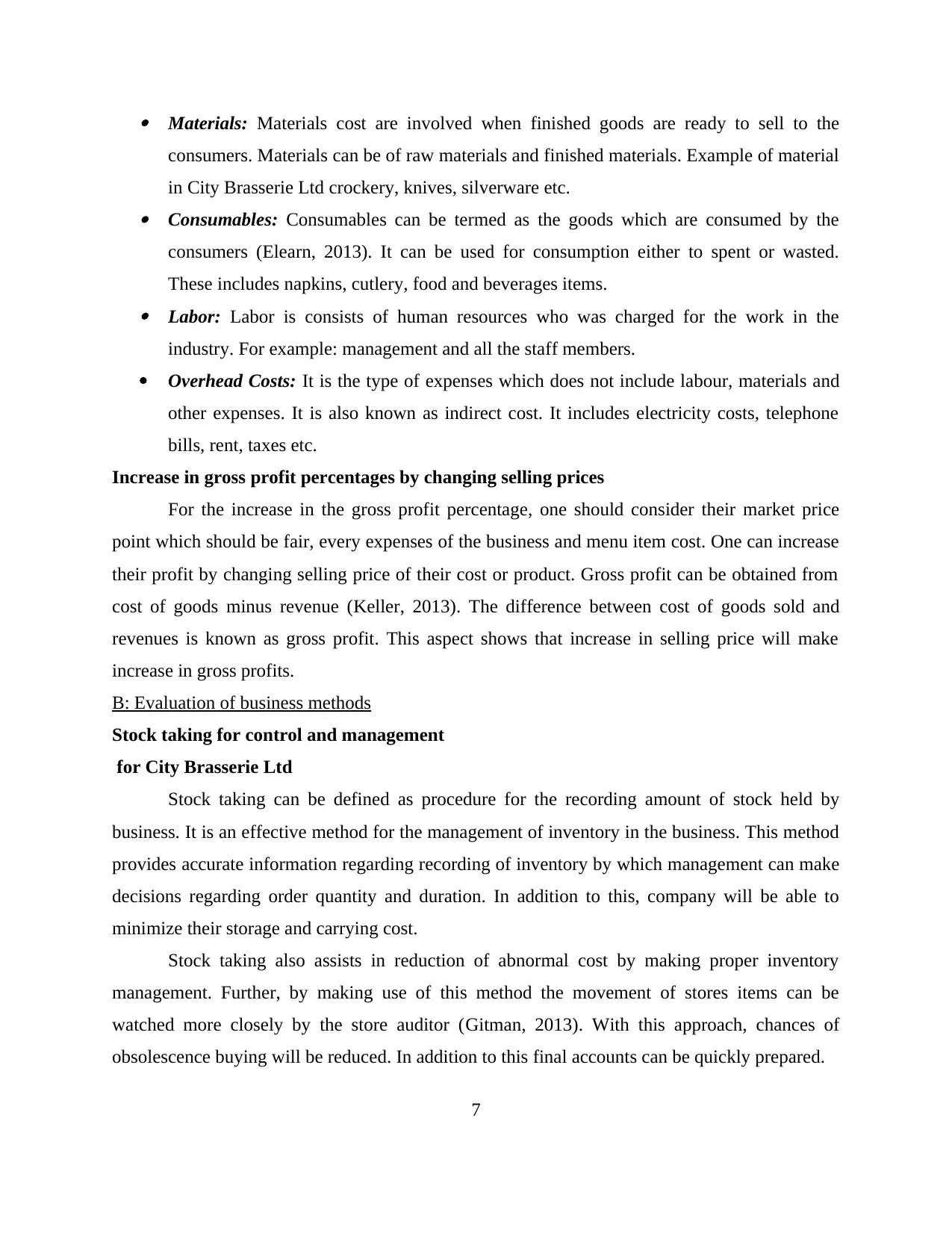
Materials: Materials cost are involved when finished goods are ready to sell to the
consumers. Materials can be of raw materials and finished materials. Example of material
in City Brasserie Ltd crockery, knives, silverware etc. Consumables: Consumables can be termed as the goods which are consumed by the
consumers (Elearn, 2013). It can be used for consumption either to spent or wasted.
These includes napkins, cutlery, food and beverages items. Labor: Labor is consists of human resources who was charged for the work in the
industry. For example: management and all the staff members.
Overhead Costs: It is the type of expenses which does not include labour, materials and
other expenses. It is also known as indirect cost. It includes electricity costs, telephone
bills, rent, taxes etc.
Increase in gross profit percentages by changing selling prices
For the increase in the gross profit percentage, one should consider their market price
point which should be fair, every expenses of the business and menu item cost. One can increase
their profit by changing selling price of their cost or product. Gross profit can be obtained from
cost of goods minus revenue (Keller, 2013). The difference between cost of goods sold and
revenues is known as gross profit. This aspect shows that increase in selling price will make
increase in gross profits.
B: Evaluation of business methods
Stock taking for control and management
for City Brasserie Ltd
Stock taking can be defined as procedure for the recording amount of stock held by
business. It is an effective method for the management of inventory in the business. This method
provides accurate information regarding recording of inventory by which management can make
decisions regarding order quantity and duration. In addition to this, company will be able to
minimize their storage and carrying cost.
Stock taking also assists in reduction of abnormal cost by making proper inventory
management. Further, by making use of this method the movement of stores items can be
watched more closely by the store auditor (Gitman, 2013). With this approach, chances of
obsolescence buying will be reduced. In addition to this final accounts can be quickly prepared.
7
consumers. Materials can be of raw materials and finished materials. Example of material
in City Brasserie Ltd crockery, knives, silverware etc. Consumables: Consumables can be termed as the goods which are consumed by the
consumers (Elearn, 2013). It can be used for consumption either to spent or wasted.
These includes napkins, cutlery, food and beverages items. Labor: Labor is consists of human resources who was charged for the work in the
industry. For example: management and all the staff members.
Overhead Costs: It is the type of expenses which does not include labour, materials and
other expenses. It is also known as indirect cost. It includes electricity costs, telephone
bills, rent, taxes etc.
Increase in gross profit percentages by changing selling prices
For the increase in the gross profit percentage, one should consider their market price
point which should be fair, every expenses of the business and menu item cost. One can increase
their profit by changing selling price of their cost or product. Gross profit can be obtained from
cost of goods minus revenue (Keller, 2013). The difference between cost of goods sold and
revenues is known as gross profit. This aspect shows that increase in selling price will make
increase in gross profits.
B: Evaluation of business methods
Stock taking for control and management
for City Brasserie Ltd
Stock taking can be defined as procedure for the recording amount of stock held by
business. It is an effective method for the management of inventory in the business. This method
provides accurate information regarding recording of inventory by which management can make
decisions regarding order quantity and duration. In addition to this, company will be able to
minimize their storage and carrying cost.
Stock taking also assists in reduction of abnormal cost by making proper inventory
management. Further, by making use of this method the movement of stores items can be
watched more closely by the store auditor (Gitman, 2013). With this approach, chances of
obsolescence buying will be reduced. In addition to this final accounts can be quickly prepared.
7
Paraphrase This Document
Need a fresh take? Get an instant paraphrase of this document with our AI Paraphraser

Appropriate methods for security of cash
Cash can be managed by various techniques such as working capital management. Cash
security issues are common in business entity. City Brasserie Ltd can appoint different
individuals for the purpose cash handling and cash recording. In this manner they can evaluate
physical balance with the accounting records in order to prevent embezzlement (Shahwan, 2008).
Further, audits can be conducted in timely manner for the monitoring in business.
TASK 3
A: Source and structure of trial balance
Trial balance can be defined as statement summarizing accounting balances of the
ledgers. This statement is prepared to ensure arithmetical accuracy of the accounting reports.
Trial balance can be prepared by two methods i.e. traditional method and modern method. This
statement is base for the preparation of financial statements. Source of information of preparation
for trial balance is balances of ledger accounts (Financial ratio and Analysis, 2013). Structure of
trial balance is comprises of following balances:
Fixed Assets, Current Assets
Long term and Current liabilities
Capital of Owners Revenue Items Expenses
Table 1: Format of trial balance
Account Name Debit Credit
Fixed and current asset
Accounts receivable £0.00
Inventory £0.00
Investments £0.00
Organization expense £0.00
Vehicles £0.00
Accumulated depreciation -
vehicles £0.00
Land £0.00
Goodwill £0.00
Long term and Current liabilities
Accounts payable £0.00
Notes payable £0.00
8
Cash can be managed by various techniques such as working capital management. Cash
security issues are common in business entity. City Brasserie Ltd can appoint different
individuals for the purpose cash handling and cash recording. In this manner they can evaluate
physical balance with the accounting records in order to prevent embezzlement (Shahwan, 2008).
Further, audits can be conducted in timely manner for the monitoring in business.
TASK 3
A: Source and structure of trial balance
Trial balance can be defined as statement summarizing accounting balances of the
ledgers. This statement is prepared to ensure arithmetical accuracy of the accounting reports.
Trial balance can be prepared by two methods i.e. traditional method and modern method. This
statement is base for the preparation of financial statements. Source of information of preparation
for trial balance is balances of ledger accounts (Financial ratio and Analysis, 2013). Structure of
trial balance is comprises of following balances:
Fixed Assets, Current Assets
Long term and Current liabilities
Capital of Owners Revenue Items Expenses
Table 1: Format of trial balance
Account Name Debit Credit
Fixed and current asset
Accounts receivable £0.00
Inventory £0.00
Investments £0.00
Organization expense £0.00
Vehicles £0.00
Accumulated depreciation -
vehicles £0.00
Land £0.00
Goodwill £0.00
Long term and Current liabilities
Accounts payable £0.00
Notes payable £0.00
8
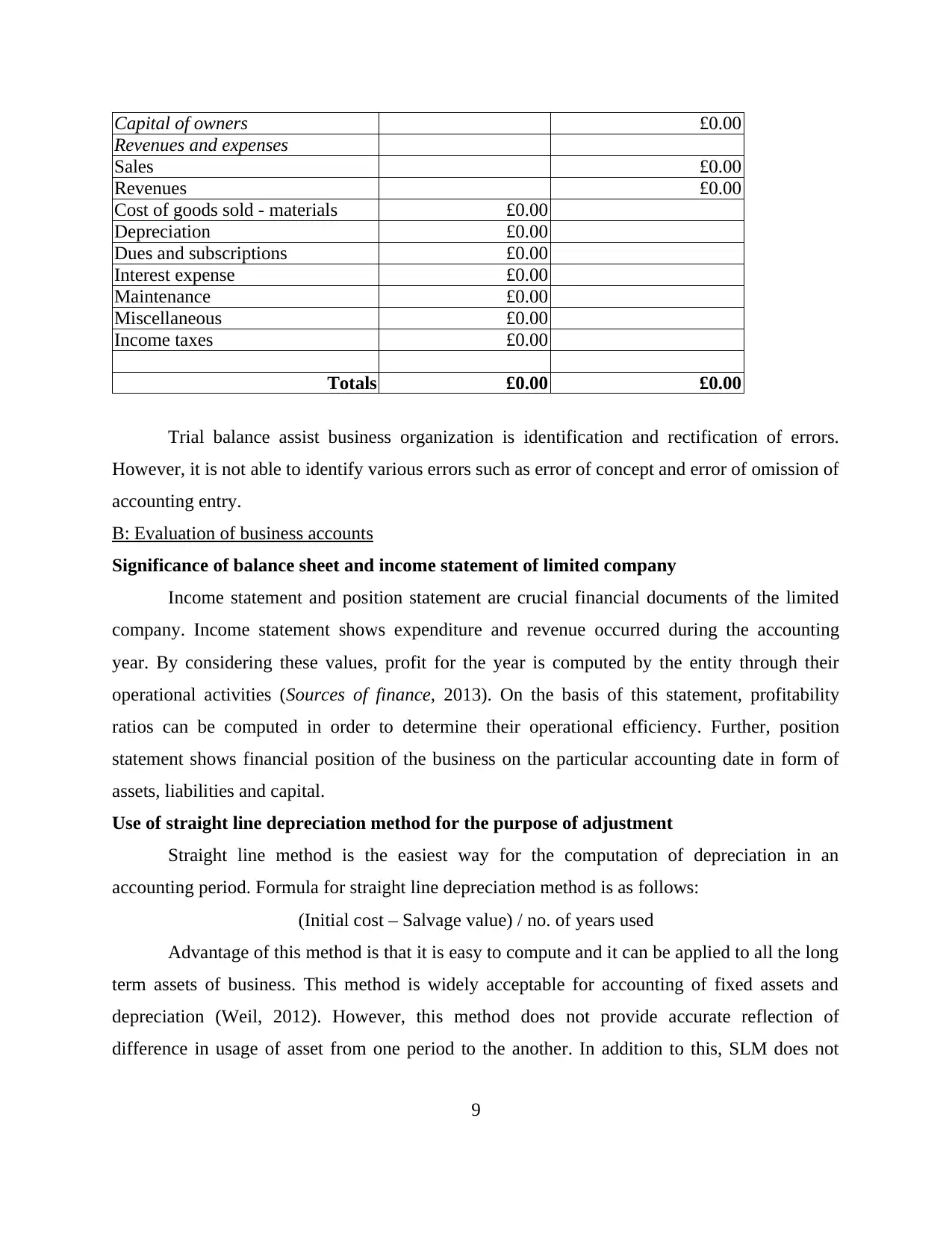
Capital of owners £0.00
Revenues and expenses
Sales £0.00
Revenues £0.00
Cost of goods sold - materials £0.00
Depreciation £0.00
Dues and subscriptions £0.00
Interest expense £0.00
Maintenance £0.00
Miscellaneous £0.00
Income taxes £0.00
Totals £0.00 £0.00
Trial balance assist business organization is identification and rectification of errors.
However, it is not able to identify various errors such as error of concept and error of omission of
accounting entry.
B: Evaluation of business accounts
Significance of balance sheet and income statement of limited company
Income statement and position statement are crucial financial documents of the limited
company. Income statement shows expenditure and revenue occurred during the accounting
year. By considering these values, profit for the year is computed by the entity through their
operational activities (Sources of finance, 2013). On the basis of this statement, profitability
ratios can be computed in order to determine their operational efficiency. Further, position
statement shows financial position of the business on the particular accounting date in form of
assets, liabilities and capital.
Use of straight line depreciation method for the purpose of adjustment
Straight line method is the easiest way for the computation of depreciation in an
accounting period. Formula for straight line depreciation method is as follows:
(Initial cost – Salvage value) / no. of years used
Advantage of this method is that it is easy to compute and it can be applied to all the long
term assets of business. This method is widely acceptable for accounting of fixed assets and
depreciation (Weil, 2012). However, this method does not provide accurate reflection of
difference in usage of asset from one period to the another. In addition to this, SLM does not
9
Revenues and expenses
Sales £0.00
Revenues £0.00
Cost of goods sold - materials £0.00
Depreciation £0.00
Dues and subscriptions £0.00
Interest expense £0.00
Maintenance £0.00
Miscellaneous £0.00
Income taxes £0.00
Totals £0.00 £0.00
Trial balance assist business organization is identification and rectification of errors.
However, it is not able to identify various errors such as error of concept and error of omission of
accounting entry.
B: Evaluation of business accounts
Significance of balance sheet and income statement of limited company
Income statement and position statement are crucial financial documents of the limited
company. Income statement shows expenditure and revenue occurred during the accounting
year. By considering these values, profit for the year is computed by the entity through their
operational activities (Sources of finance, 2013). On the basis of this statement, profitability
ratios can be computed in order to determine their operational efficiency. Further, position
statement shows financial position of the business on the particular accounting date in form of
assets, liabilities and capital.
Use of straight line depreciation method for the purpose of adjustment
Straight line method is the easiest way for the computation of depreciation in an
accounting period. Formula for straight line depreciation method is as follows:
(Initial cost – Salvage value) / no. of years used
Advantage of this method is that it is easy to compute and it can be applied to all the long
term assets of business. This method is widely acceptable for accounting of fixed assets and
depreciation (Weil, 2012). However, this method does not provide accurate reflection of
difference in usage of asset from one period to the another. In addition to this, SLM does not
9
⊘ This is a preview!⊘
Do you want full access?
Subscribe today to unlock all pages.

Trusted by 1+ million students worldwide
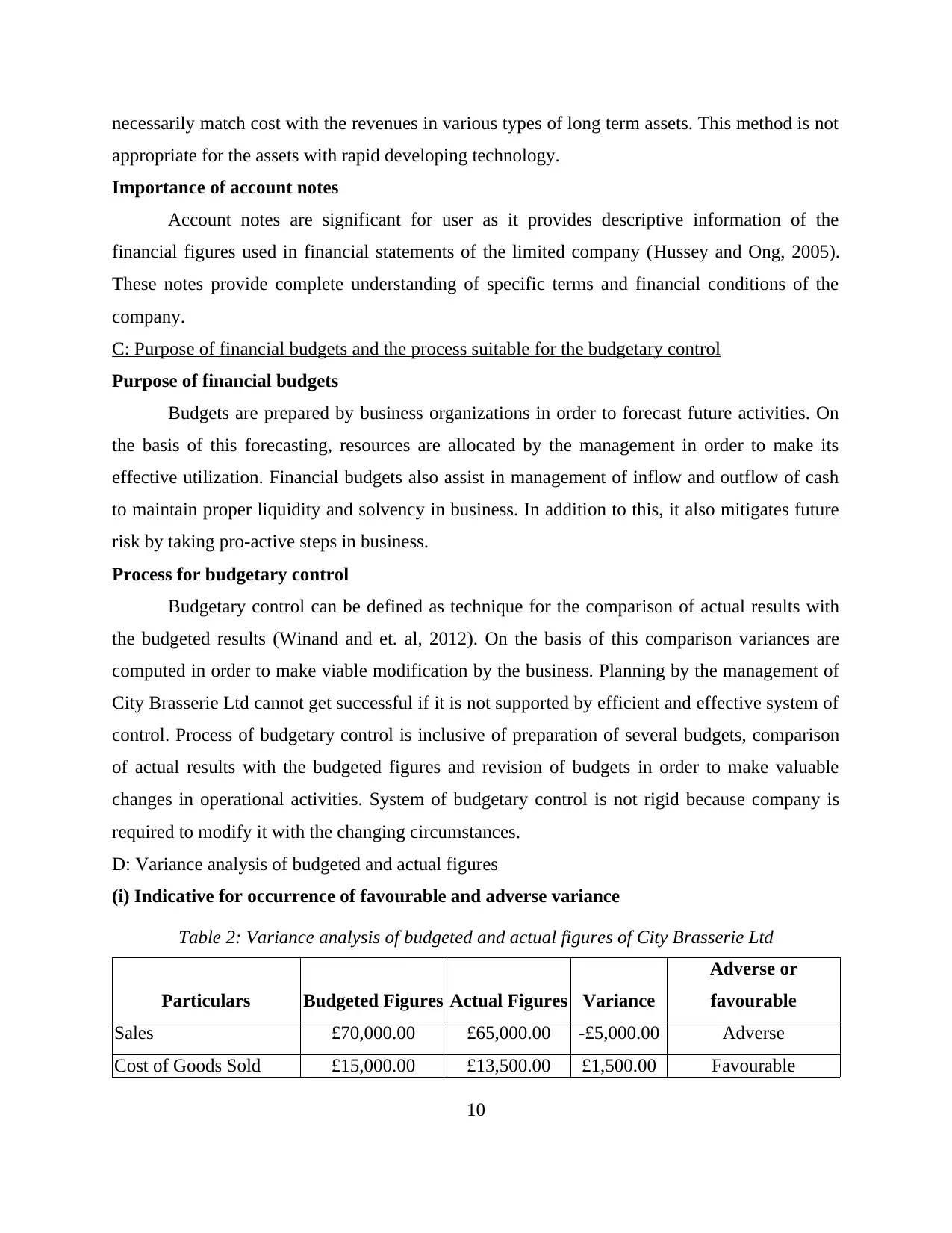
necessarily match cost with the revenues in various types of long term assets. This method is not
appropriate for the assets with rapid developing technology.
Importance of account notes
Account notes are significant for user as it provides descriptive information of the
financial figures used in financial statements of the limited company (Hussey and Ong, 2005).
These notes provide complete understanding of specific terms and financial conditions of the
company.
C: Purpose of financial budgets and the process suitable for the budgetary control
Purpose of financial budgets
Budgets are prepared by business organizations in order to forecast future activities. On
the basis of this forecasting, resources are allocated by the management in order to make its
effective utilization. Financial budgets also assist in management of inflow and outflow of cash
to maintain proper liquidity and solvency in business. In addition to this, it also mitigates future
risk by taking pro-active steps in business.
Process for budgetary control
Budgetary control can be defined as technique for the comparison of actual results with
the budgeted results (Winand and et. al, 2012). On the basis of this comparison variances are
computed in order to make viable modification by the business. Planning by the management of
City Brasserie Ltd cannot get successful if it is not supported by efficient and effective system of
control. Process of budgetary control is inclusive of preparation of several budgets, comparison
of actual results with the budgeted figures and revision of budgets in order to make valuable
changes in operational activities. System of budgetary control is not rigid because company is
required to modify it with the changing circumstances.
D: Variance analysis of budgeted and actual figures
(i) Indicative for occurrence of favourable and adverse variance
Table 2: Variance analysis of budgeted and actual figures of City Brasserie Ltd
Particulars Budgeted Figures Actual Figures Variance
Adverse or
favourable
Sales £70,000.00 £65,000.00 -£5,000.00 Adverse
Cost of Goods Sold £15,000.00 £13,500.00 £1,500.00 Favourable
10
appropriate for the assets with rapid developing technology.
Importance of account notes
Account notes are significant for user as it provides descriptive information of the
financial figures used in financial statements of the limited company (Hussey and Ong, 2005).
These notes provide complete understanding of specific terms and financial conditions of the
company.
C: Purpose of financial budgets and the process suitable for the budgetary control
Purpose of financial budgets
Budgets are prepared by business organizations in order to forecast future activities. On
the basis of this forecasting, resources are allocated by the management in order to make its
effective utilization. Financial budgets also assist in management of inflow and outflow of cash
to maintain proper liquidity and solvency in business. In addition to this, it also mitigates future
risk by taking pro-active steps in business.
Process for budgetary control
Budgetary control can be defined as technique for the comparison of actual results with
the budgeted results (Winand and et. al, 2012). On the basis of this comparison variances are
computed in order to make viable modification by the business. Planning by the management of
City Brasserie Ltd cannot get successful if it is not supported by efficient and effective system of
control. Process of budgetary control is inclusive of preparation of several budgets, comparison
of actual results with the budgeted figures and revision of budgets in order to make valuable
changes in operational activities. System of budgetary control is not rigid because company is
required to modify it with the changing circumstances.
D: Variance analysis of budgeted and actual figures
(i) Indicative for occurrence of favourable and adverse variance
Table 2: Variance analysis of budgeted and actual figures of City Brasserie Ltd
Particulars Budgeted Figures Actual Figures Variance
Adverse or
favourable
Sales £70,000.00 £65,000.00 -£5,000.00 Adverse
Cost of Goods Sold £15,000.00 £13,500.00 £1,500.00 Favourable
10
Paraphrase This Document
Need a fresh take? Get an instant paraphrase of this document with our AI Paraphraser
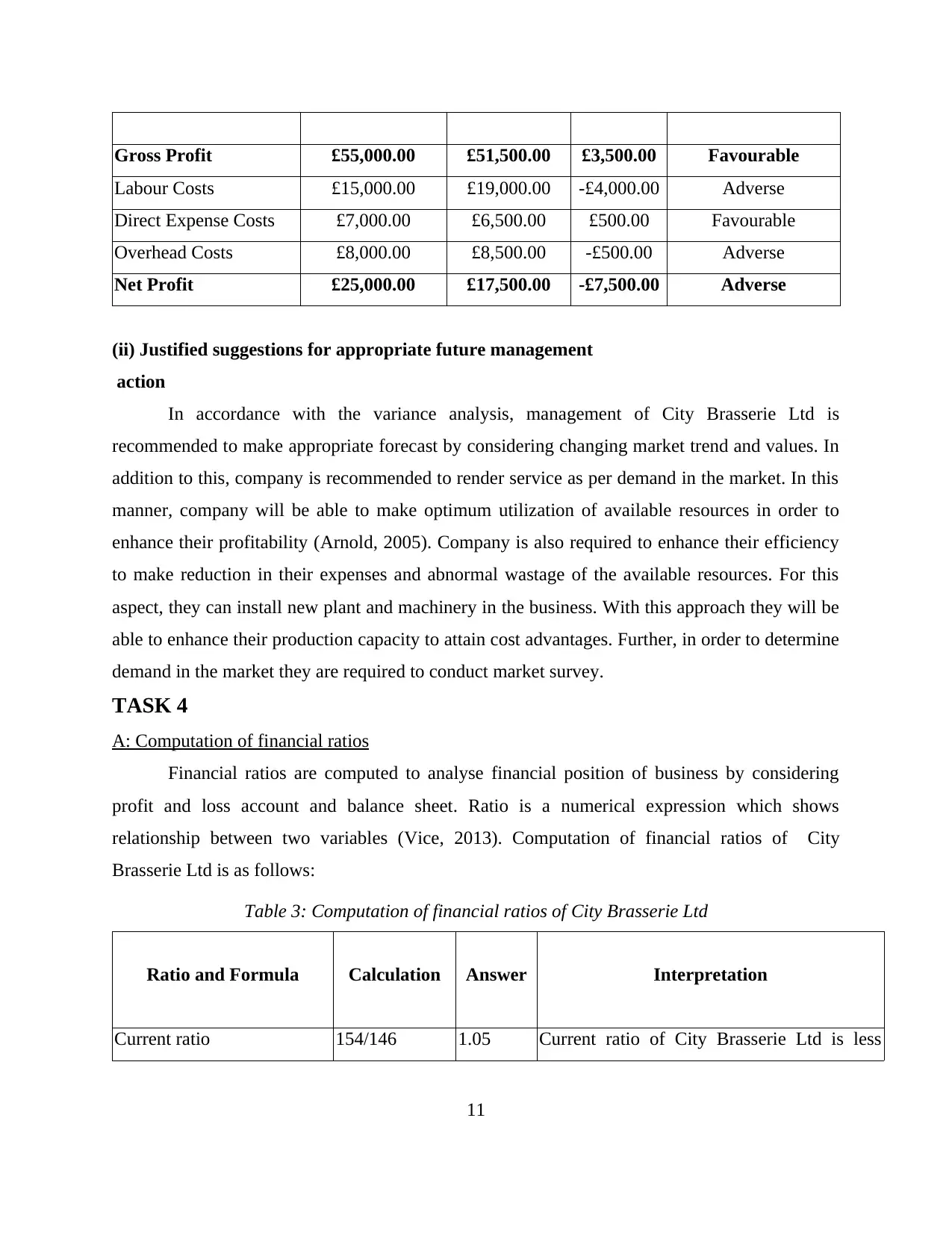
Gross Profit £55,000.00 £51,500.00 £3,500.00 Favourable
Labour Costs £15,000.00 £19,000.00 -£4,000.00 Adverse
Direct Expense Costs £7,000.00 £6,500.00 £500.00 Favourable
Overhead Costs £8,000.00 £8,500.00 -£500.00 Adverse
Net Profit £25,000.00 £17,500.00 -£7,500.00 Adverse
(ii) Justified suggestions for appropriate future management
action
In accordance with the variance analysis, management of City Brasserie Ltd is
recommended to make appropriate forecast by considering changing market trend and values. In
addition to this, company is recommended to render service as per demand in the market. In this
manner, company will be able to make optimum utilization of available resources in order to
enhance their profitability (Arnold, 2005). Company is also required to enhance their efficiency
to make reduction in their expenses and abnormal wastage of the available resources. For this
aspect, they can install new plant and machinery in the business. With this approach they will be
able to enhance their production capacity to attain cost advantages. Further, in order to determine
demand in the market they are required to conduct market survey.
TASK 4
A: Computation of financial ratios
Financial ratios are computed to analyse financial position of business by considering
profit and loss account and balance sheet. Ratio is a numerical expression which shows
relationship between two variables (Vice, 2013). Computation of financial ratios of City
Brasserie Ltd is as follows:
Table 3: Computation of financial ratios of City Brasserie Ltd
Ratio and Formula Calculation Answer Interpretation
Current ratio 154/146 1.05 Current ratio of City Brasserie Ltd is less
11
Labour Costs £15,000.00 £19,000.00 -£4,000.00 Adverse
Direct Expense Costs £7,000.00 £6,500.00 £500.00 Favourable
Overhead Costs £8,000.00 £8,500.00 -£500.00 Adverse
Net Profit £25,000.00 £17,500.00 -£7,500.00 Adverse
(ii) Justified suggestions for appropriate future management
action
In accordance with the variance analysis, management of City Brasserie Ltd is
recommended to make appropriate forecast by considering changing market trend and values. In
addition to this, company is recommended to render service as per demand in the market. In this
manner, company will be able to make optimum utilization of available resources in order to
enhance their profitability (Arnold, 2005). Company is also required to enhance their efficiency
to make reduction in their expenses and abnormal wastage of the available resources. For this
aspect, they can install new plant and machinery in the business. With this approach they will be
able to enhance their production capacity to attain cost advantages. Further, in order to determine
demand in the market they are required to conduct market survey.
TASK 4
A: Computation of financial ratios
Financial ratios are computed to analyse financial position of business by considering
profit and loss account and balance sheet. Ratio is a numerical expression which shows
relationship between two variables (Vice, 2013). Computation of financial ratios of City
Brasserie Ltd is as follows:
Table 3: Computation of financial ratios of City Brasserie Ltd
Ratio and Formula Calculation Answer Interpretation
Current ratio 154/146 1.05 Current ratio of City Brasserie Ltd is less
11
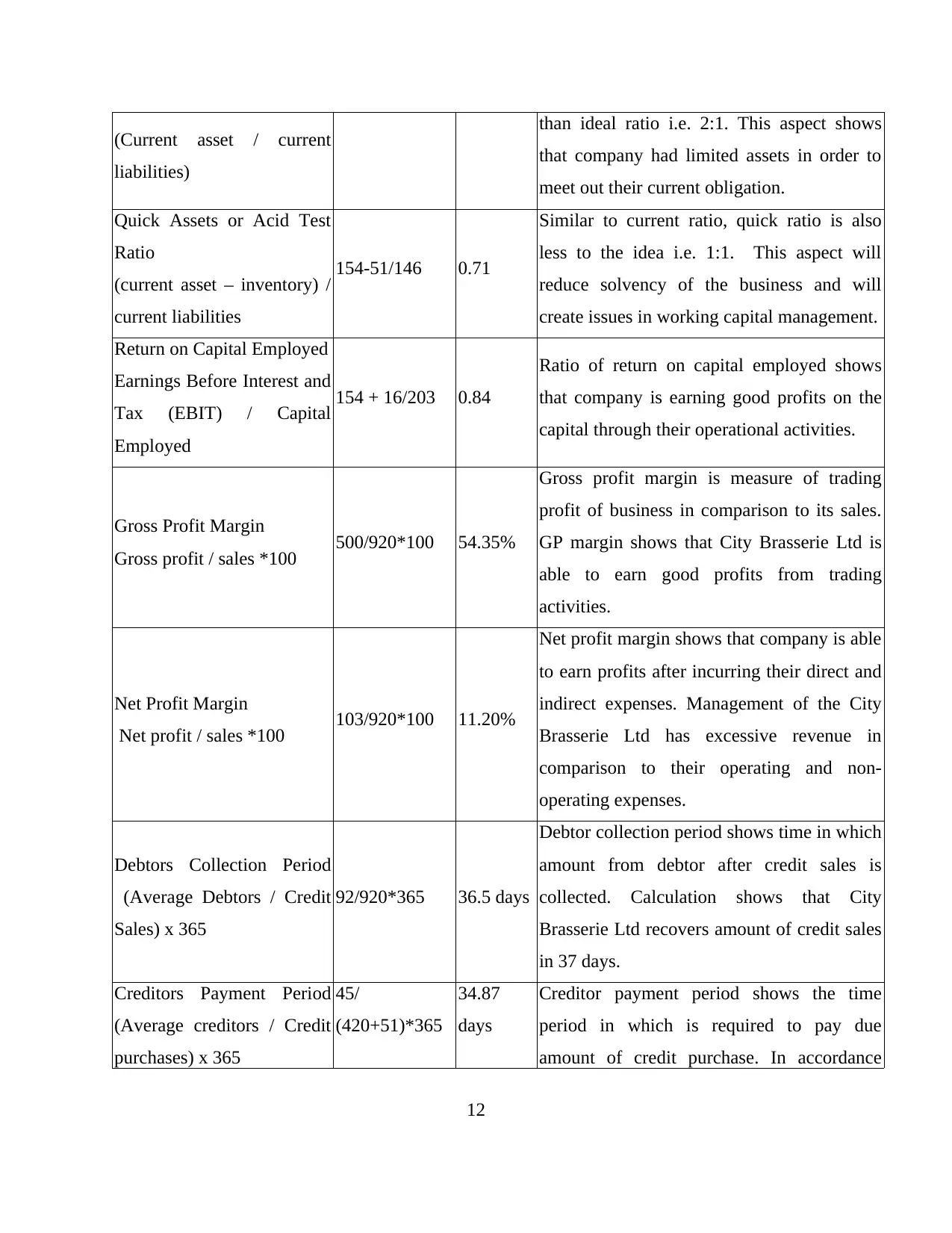
(Current asset / current
liabilities)
than ideal ratio i.e. 2:1. This aspect shows
that company had limited assets in order to
meet out their current obligation.
Quick Assets or Acid Test
Ratio
(current asset – inventory) /
current liabilities
154-51/146 0.71
Similar to current ratio, quick ratio is also
less to the idea i.e. 1:1. This aspect will
reduce solvency of the business and will
create issues in working capital management.
Return on Capital Employed
Earnings Before Interest and
Tax (EBIT) / Capital
Employed
154 + 16/203 0.84
Ratio of return on capital employed shows
that company is earning good profits on the
capital through their operational activities.
Gross Profit Margin
Gross profit / sales *100 500/920*100 54.35%
Gross profit margin is measure of trading
profit of business in comparison to its sales.
GP margin shows that City Brasserie Ltd is
able to earn good profits from trading
activities.
Net Profit Margin
Net profit / sales *100 103/920*100 11.20%
Net profit margin shows that company is able
to earn profits after incurring their direct and
indirect expenses. Management of the City
Brasserie Ltd has excessive revenue in
comparison to their operating and non-
operating expenses.
Debtors Collection Period
(Average Debtors / Credit
Sales) x 365
92/920*365 36.5 days
Debtor collection period shows time in which
amount from debtor after credit sales is
collected. Calculation shows that City
Brasserie Ltd recovers amount of credit sales
in 37 days.
Creditors Payment Period
(Average creditors / Credit
purchases) x 365
45/
(420+51)*365
34.87
days
Creditor payment period shows the time
period in which is required to pay due
amount of credit purchase. In accordance
12
liabilities)
than ideal ratio i.e. 2:1. This aspect shows
that company had limited assets in order to
meet out their current obligation.
Quick Assets or Acid Test
Ratio
(current asset – inventory) /
current liabilities
154-51/146 0.71
Similar to current ratio, quick ratio is also
less to the idea i.e. 1:1. This aspect will
reduce solvency of the business and will
create issues in working capital management.
Return on Capital Employed
Earnings Before Interest and
Tax (EBIT) / Capital
Employed
154 + 16/203 0.84
Ratio of return on capital employed shows
that company is earning good profits on the
capital through their operational activities.
Gross Profit Margin
Gross profit / sales *100 500/920*100 54.35%
Gross profit margin is measure of trading
profit of business in comparison to its sales.
GP margin shows that City Brasserie Ltd is
able to earn good profits from trading
activities.
Net Profit Margin
Net profit / sales *100 103/920*100 11.20%
Net profit margin shows that company is able
to earn profits after incurring their direct and
indirect expenses. Management of the City
Brasserie Ltd has excessive revenue in
comparison to their operating and non-
operating expenses.
Debtors Collection Period
(Average Debtors / Credit
Sales) x 365
92/920*365 36.5 days
Debtor collection period shows time in which
amount from debtor after credit sales is
collected. Calculation shows that City
Brasserie Ltd recovers amount of credit sales
in 37 days.
Creditors Payment Period
(Average creditors / Credit
purchases) x 365
45/
(420+51)*365
34.87
days
Creditor payment period shows the time
period in which is required to pay due
amount of credit purchase. In accordance
12
⊘ This is a preview!⊘
Do you want full access?
Subscribe today to unlock all pages.

Trusted by 1+ million students worldwide
1 out of 17
Related Documents
Your All-in-One AI-Powered Toolkit for Academic Success.
+13062052269
info@desklib.com
Available 24*7 on WhatsApp / Email
![[object Object]](/_next/static/media/star-bottom.7253800d.svg)
Unlock your academic potential
Copyright © 2020–2026 A2Z Services. All Rights Reserved. Developed and managed by ZUCOL.




